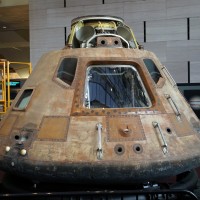Graffiti in Space
Sometimes you just can’t find a notepad handy when you need one. A new 3D digitization effort by the Air and Space Museum shows that even astronauts will scribble notes on the wall.

While 3D scanning the Apollo 11 Command Module Columbia, museum staff uncovered writing on its interior walls. Among the notations is this tribute to the Cpmmand Module itself signed by mission commander Michael Collins. (NASM photo)
So it looks like landing on the moon wasn’t the only thing the crew were doing inside the Apollo 11 Command Module Columbia in July of 1969. Staff from the National Air and Space Museum in Washington, D.C. and the Smithsonian’s 3D Digitization Program have discovered writing on the interior walls of the command module―something that was previously unknown to the Smithsonian. The astronaut graffiti, unseen for almost 50 years, includes notes, figures and a calendar presumably written by the crew during their historic flight to the moon.
The writing gives a unique look into the first mission to land on the moon, crewed by Neil Armstrong, Buzz Aldrin and Michael Collins between July 16 and 24, 1969. The discovery of this “space graffiti” will enable the museum’s curators to compile a more complete account of how the missions were conducted.
- The Apollo 11 Command Module Columbia on display at the National Air and Space Museum in Washington, D.C. (Photo by John Gibbons)
- While 3D scanning the Apollo 11 Command Module Columbia, museum staff uncovered writing on its interior walls. On this panel, numbers and other notations copied from mission control voice transmissions were recorded in pen or pencil, just to the left of where command module pilot, Michael Collins, would have stood using the spacecraft’s sextant and telescope for navigation. Audio and recorded transcripts of those communications can be compared with these numbers to suggest when and by whom they were written. (NASM photo)
- All three Apollo 11 astronauts were quarantined for several weeks following the mission at the Lunar Receiving Laboratory at the Johnson Space Center in Texas. Quarantined with them was a photographer and technician, John Harasaki, who was given the job of removing essential items from the Command Module and decontaminating the interior. This image was taken during the quarantine period and shows the condition of the cabin shortly after its arrival back in the country. Note the calendar visible just to the left of Harasaki. (NASA photo)
- While 3D scanning the Apollo 11 Command Module, museum staff uncovered writing on the interior walls of the module.The main control panel of the spacecraft contains essential switches and indicators that had to be referred to and operated during the most crucial aspects of the flight. Numbers and references written by hand onto the panel can be checked against the audio and written transcripts from the mission to provide a more vivid picture of just what transpired. (NASM photo)
- During the 3D scanning project of the Apollo 11 Command Module, museum staff uncovered writing on the interior walls of the module. At some point during the mission, one of the astronauts created a small calendar on a smooth wall below one of the lockers. Each day of the Apollo 11 mission is crossed out except for landing day. The calendar is covered with a plastic sheet held by tape. Museum curators are in the process of trying to determine just when the calendar was drawn. (NASM photo)
“As curator of what is arguably one of the most iconic artifacts in the entire Smithsonian collection, it’s thrilling to know that we can still learn new things about Columbia,” says Allan Needell, curator of space history at the museum. “This isn’t just a piece of machinery, it’s a living artifact.”
The curators at the National Air and Space Museum have been working with the Smithsonian’s 3D Digitization Program to scan the command module in 3D to create a high resolution interactive model of the entire spacecraft. This highly detailed model will allow researchers and the public to explore the entire craft, a feat not possible when viewing the artifact in the museum. The model will be used to produce an interactive display in the museum’s exhibition “Destination Moon,” scheduled to open in 2020.
“We want to allow anyone with an internet connection the ability to experience what is was like to sit in the cockpit of the Apollo Command Module,” said Vince Rossi, 3D imaging specialist with the Smithsonian’s 3D Digitization Program. “Beyond virtually navigating the interior of the Command Module our goal is to use this 3D model as a storytelling tool for the National Air Space Museum Curators and Conservators using our 3d viewer on 3d.si.edu.”
Because of the complicated nature of this scan, the Smithsonian 3D team brought in its technology partner, software company Autodesk Inc. Autodesk deployed specially designed equipment to scan the artifact and its advanced software was able to process complex data from multiple 3D capture devices to create one highly detailed and accurate model.
“Our goal is to launch the Command Module to the public in the summer of 2016. Stay tuned,” said Rossi.
The Smthsonian’s 3D Digitization Program has been working to digitize the Apollo 11 Command Module “Columbia” that is currently on display at the National Air and Space museum. “Columbia” was the living quarters for the three-person crew during most of the first manned lunar landing mission in July 1969.
A version of this post was originally published by SmithsonianScienceNews.org
Posted: 16 February 2016








